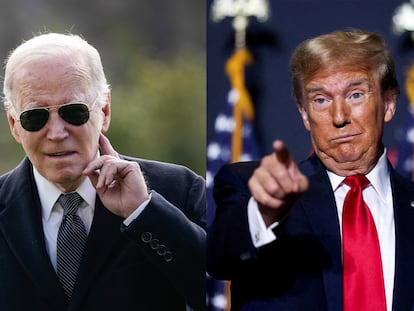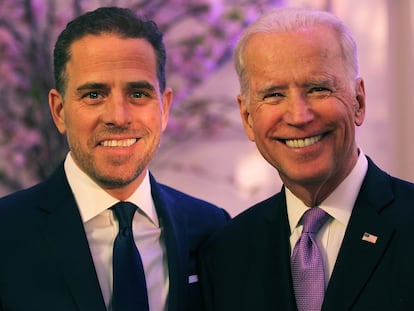Wall Street looks askance at the White House
The uncertainty about who will be the new US president is sure to bring some degree of volatility, but in the medium term investors will be more focused on the economic situation

This year the ballot boxes will be out in force. In 2024, 3.7 billion people in 70 countries are being asked to vote. At the beginning of June, there will be elections in the European Union to determine the makeup of the EU Parliament. Throughout 2024, new governments will also be elected in India, Pakistan, Brazil, Mexico, Belgium, Bulgaria and more. Elections are piling up, but if one stands out above the rest it is the one to choose the next tenant of the White House. The U.S. presidential election will be held on Tuesday, November 5. Until then, for one reason or another, this particular election will be on everyone’s lips. Until June, because the states and political parties are holding primaries and caucuses. From July to early September, because both Democrats and Republicans will hold their national conventions to elect their candidates. And, later, because there will be debates between the presidential nominees who, barring last-minute surprises, will be the current president, Joe Biden, and his predecessor, Donald Trump.
How will the electoral uncertainty surrounding the world’s leading economic power affect the markets? Experts from the management company Panza Capital warn that “months of noise” are coming for Wall Street and the stock market “due to the importance of the United States in the financial world.” At JP Morgan Private Bank, sources underscore that election years “tend to be more volatile than the rest, especially in the period prior to voting day.” Schroders and Capital Group share this opinion and point out that it is more than likely that markets will be affected by the uncertainty about the final outcome and, above all, the makeup of the House of Representatives and the Senate. In these experts’ opinion, some people will try to anticipate the impact that these results may have on monetary and fiscal policy, on climate change and immigration, and as a side effect on certain listed sectors that might theoretically benefit or be harmed, depending on the policies of the next president.
Yet despite this greater electoral volatility on prices, all the experts consulted by this newspaper believe that the real impact of the U.S. election on the markets in the medium and long term must be put into perspective.
At Capital Group, for example, a source explained that there has always been very little difference in stock market performance under Republican and Democratic presidents. Since 1936, the 10-year annualized return on U.S. shares (as measured by the S&P 500 index) since the start of an election year was 11.2% when the Democratic Party won the election and 10.5% when the winner was the Republican Party.
Historical series
According to an analysis by J.P. Morgan Private Bank, returns usually do not differ much in election years. “If we go back to 1928 [since we have data], the average return on stocks in election years was 7.5%, compared to 8.0% in non-election years.” Nor is it true, in this expert’s opinion, that the markets will sink if one specific candidate wins: “We have seen booms and busts on both sides of the political spectrum. The economic background tends to matter more.”
It is precisely this macroeconomic background that, over at Schroders, analysts believe will determine the behavior of the financial markets in 2024. In their opinion, if a cut in interest rates occurs, as initially planned, a positive performance can be expected from both stocks and bonds. According to one of its most recent reports on historical data on investment returns during 22 cycles of U.S. interest rate cuts, since 1928, the average return on U.S. stocks has been 11% higher than inflation in the 12 months after the Federal Reserve began interest rate cuts. Stocks also outperformed government bonds by 6% and corporate bonds by 5% on average. Equities have also outperformed cash by 9% on average in the 12 months since the rate cut began.
At Panza Capital, they believe that investors should not change their long-term strategy, “no matter how much of an election year it is in the U.S.” In their opinion, selecting investments based on the expectations of who will be sitting in the White House can be a mistake, “not only because it is difficult to know what is going to happen, but it is even more difficult to know how they are going to react.” Analysts insist on this idea, noting that “although with Joe Biden in the presidency one might expect the most favored sectors to be those linked to green energy, climate change or pharmaceuticals, the reality is that it has been the other way around, with more positive behavior, apart from technology, in the financial, defense and even the oil sectors.” These experts recall that even though Democrats and Republicans make different political proposals that could alter expectations of growth and benefits in some sectors, “the reality is that these proposals do not always end up going ahead.” In this sense, analysts at Capital Group point out that when everyone gets concerned that a new government policy might destroy a sector, this concern “is usually exaggerated.”
Taking into account that there is still a long way to go until the U.S. election in November, analysts at J.P. Morgan conclude that, although politics can evoke strong emotions, investors should not lose sight of their long-term investment objectives. “We believe that the economy will continue to be the predominant driver of political decisions and markets in general.” In their opinion there are still risks arising from current elements of friction, such as inflation, to unforeseen events related to geopolitics, but as long as growth is maintained, pressures on prices will decrease and the Federal Reserve will embark on a path of monetary easing, creating ample opportunities for investors in multi-asset funds in the coming year.
Sign up for our weekly newsletter to get more English-language news coverage from EL PAÍS USA Edition
Tu suscripción se está usando en otro dispositivo
¿Quieres añadir otro usuario a tu suscripción?
Si continúas leyendo en este dispositivo, no se podrá leer en el otro.
FlechaTu suscripción se está usando en otro dispositivo y solo puedes acceder a EL PAÍS desde un dispositivo a la vez.
Si quieres compartir tu cuenta, cambia tu suscripción a la modalidad Premium, así podrás añadir otro usuario. Cada uno accederá con su propia cuenta de email, lo que os permitirá personalizar vuestra experiencia en EL PAÍS.
¿Tienes una suscripción de empresa? Accede aquí para contratar más cuentas.
En el caso de no saber quién está usando tu cuenta, te recomendamos cambiar tu contraseña aquí.
Si decides continuar compartiendo tu cuenta, este mensaje se mostrará en tu dispositivo y en el de la otra persona que está usando tu cuenta de forma indefinida, afectando a tu experiencia de lectura. Puedes consultar aquí los términos y condiciones de la suscripción digital.
More information
Archived In
Últimas noticias
Most viewed
- Sinaloa Cartel war is taking its toll on Los Chapitos
- Oona Chaplin: ‘I told James Cameron that I was living in a treehouse and starting a permaculture project with a friend’
- Reinhard Genzel, Nobel laureate in physics: ‘One-minute videos will never give you the truth’
- Why the price of coffee has skyrocketed: from Brazilian plantations to specialty coffee houses
- Silver prices are going crazy: This is what’s fueling the rally










































